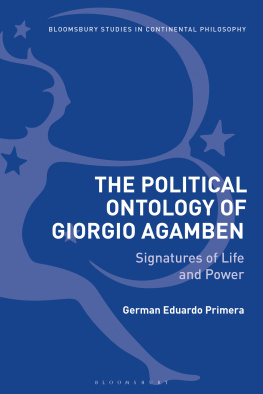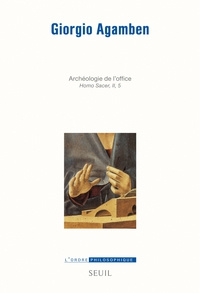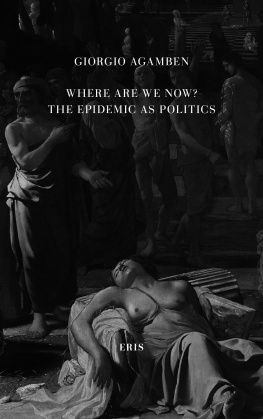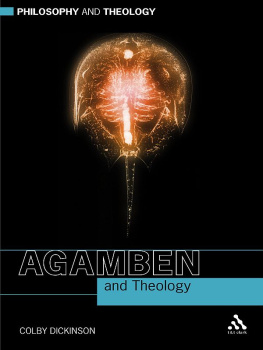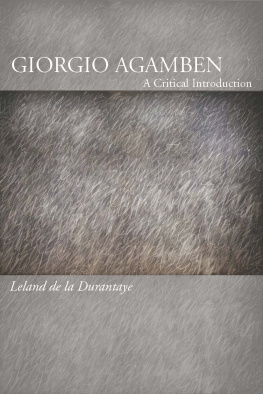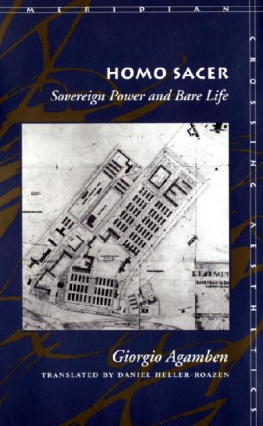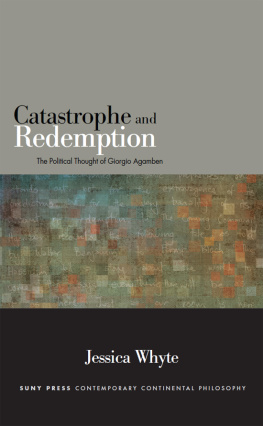German Eduardo Primera - The Political Ontology of Giorgio Agamben Signatures of Life and Power
Here you can read online German Eduardo Primera - The Political Ontology of Giorgio Agamben Signatures of Life and Power full text of the book (entire story) in english for free. Download pdf and epub, get meaning, cover and reviews about this ebook. year: 2019, publisher: Bloomsbury UK, genre: Science. Description of the work, (preface) as well as reviews are available. Best literature library LitArk.com created for fans of good reading and offers a wide selection of genres:
Romance novel
Science fiction
Adventure
Detective
Science
History
Home and family
Prose
Art
Politics
Computer
Non-fiction
Religion
Business
Children
Humor
Choose a favorite category and find really read worthwhile books. Enjoy immersion in the world of imagination, feel the emotions of the characters or learn something new for yourself, make an fascinating discovery.
- Book:The Political Ontology of Giorgio Agamben Signatures of Life and Power
- Author:
- Publisher:Bloomsbury UK
- Genre:
- Year:2019
- Rating:3 / 5
- Favourites:Add to favourites
- Your mark:
- 60
- 1
- 2
- 3
- 4
- 5
The Political Ontology of Giorgio Agamben Signatures of Life and Power: summary, description and annotation
We offer to read an annotation, description, summary or preface (depends on what the author of the book "The Political Ontology of Giorgio Agamben Signatures of Life and Power" wrote himself). If you haven't found the necessary information about the book — write in the comments, we will try to find it.
The Political Ontology of Giorgio Agamben Signatures of Life and Power — read online for free the complete book (whole text) full work
Below is the text of the book, divided by pages. System saving the place of the last page read, allows you to conveniently read the book "The Political Ontology of Giorgio Agamben Signatures of Life and Power" online for free, without having to search again every time where you left off. Put a bookmark, and you can go to the page where you finished reading at any time.
Font size:
Interval:
Bookmark:

The Political Ontology of Giorgio Agamben
Also available from Bloomsbury
The Withholding Power , Massimo Cacciari
Apocalyptic Political Theology , Thomas Lynch
Towards the Critique of Violence , edited by Brendan Moran and Carlo Salzani
Cinema and Agamben , edited by Henrik Gustafsson and Asbjrn Grnstad
Agamben and Theology , Colby Dickinson
Enactment, Politics, and Truth , Antonio Cimino
The Literary Agamben , William Watkin
On Pilgrims, Polities, Agamben and Arendt , Peter Iver Kaufman
To Belsy, Martha, Mariela and Carmela in memoriam
The Political Ontology of Giorgio Agamben
Signatures of Life and Power
German Eduardo Primera

Contents
My first thanks go to Mark Devenney and Daniel Steuer who, throughout my years of study, provided insightful theoretical guidance, support and inspiration. Their commitment to my research was beyond expectations. I would also like to thank my colleagues and friends in Brighton who have created an intellectually stimulating environment and have provided a proper home for my research.
I must also thank Anthony Leaker, Yannis Stavrakakis, Lars Cornelissen, Afxentis Afxentiou, Melayna Lamb and Clare Woodford for the critical and constructive feedback they have given me. I am grateful to Mark Able and Tom Hickey for providing me with a thoughtful critique of some of these chapters. I would also like to express my appreciation for The Centre for Applied Philosophy, Politics and Ethics and the School of Humanities in the University of Brighton for their support to my research. On a personal level, my sincere gratitude is due to my dear friends and family: Melayna Lamb, Mike Lewis, William Jaimes, Rosana Villamizar, Tim Huzar, Jose Primera, Jessica Primera and Carole Blomme for their encouragement, sustenance and affection during the writing of this work.
Some sections of this book have developed from previous publications. Part of Chapter 3 was published as Potentiality, Sovereignty and Bare Life: A Critical Reading of Giorgio Agamben, in Revista Ideas y Valores , N. 156, Dic 2014, pp. 7999; Chapter 5 borrows from my article Economic theology, Governance and Neoliberalism, in Theoretical Practice , no. 3, 2015, pp. 10622. And finally, a shorter version of Chapter 7 was published as Violence, Biopolitics and Resistance: The Meaning of Violence in the Work of Giorgio Agamben, in The Meanings of Violence: From Critical Theory to Biopolitics , ed. Gavin Rae and Emma Ingala, London: Routledge, 2018, pp. 20928.
The genuine philosophical element in every work, whether it be a work of art, science or thought, is its capacity to be developed, which Ludwig Feuerbach defined as Entwicklungsfhigkeit . It is precisely when one follows such a principle that the difference between what belongs to the author of a work and what is attributable to the interpreter becomes as essential as it is difficult to grasp. I have therefore preferred to take the risk of attributing to the texts of others what began its elaboration with them, rather than run the reverse risk of appropriating thoughts or research paths that do not belong to me.
()
In the series of lectures published under the title of On Time and Being Heidegger claims that the task of his philosophy has been to trace Being to its own from Appropriation by way of looking through true time without regard to the relation of Being to beings (:24). The philosophy of Giorgio Agamben, although indebted to Heidegger in decisive ways, intends to prove Heideggers strategy wrong: it is a critique of Western metaphysics that aims at its suspension, at rendering inoperative the signatures that control the intelligibility of Western politics and culture. In other words, it precisely aims at overcoming metaphysics.
Nevertheless, if leaving metaphysics to itself is not the right strategy for Agamben, nor is the attempt to destabilize it from the inside. Indeed, it is not by reversing the terms of the hierarchy of the phon / logos , identity/difference, signified/signifier oppositions that the metaphysical machine can be :xii).
If Derridas powerful critique of metaphysics targets the idea of presence, Agamben contends that the removal of presence whether that be the removal of the voice, of being or of the signified is still trapped in the metaphysical machine in the form of negation. But, what is the underlying structure of metaphysics? How does Agamben propose to render the metaphysical machine inoperative? And, how is it possible to think language and Being beyond the ideas of death and negation? Or, simply put, what is the philosophical method developed by Agamben and what can it tell us about his philosophical system and his political thought?
A reflection on method, writes Agamben in the preface to The Signature of All Things , usually follows practical application, rather than preceding it. It is a matter then, of ultimate and penultimate thoughts (2009a:7). And yet, for Agamben, in philosophy like in art, no conclusion is possible, you can only abandon your work (2013c:1). With the publication of The Use of Bodies () we now have access to the entirety of the Homo Sacer project, which has come to an end, or to paraphrase Agamben, has been abandoned. A new vantage point from which to reread Agambens oeuvre is now accessible. Not only his method but also and as a consequence of this his political and philosophical thought can be seen in a clearer light.
The general purpose of this book is to rethink the notions of life and power two of the central themes in Agambens work through a reconstruction of his philosophical method and the examination of his critique of Western metaphysics. It is commonly asserted, especially within the field of political theory, that there are, as it were, two Agambens. In some debates, Agambens early and influential writings on signification, language and metaphysics are disregarded, ignored or superseded by the wide reception of the first volume of the Homo Sacer project, which, in turn, is frequently read in isolation not only from Agambens earlier writings but also from the other seven volumes that constitute the project. Others, such Antonio Negri, read Agambens work in its entirety but claim that there is a rupture between the themes and the philosophical method developed by Agamben:
It seems that there are two Agambens. There is the one who lingers in the existential, destining, and terrifying shadows, where he is perpetually forced into a confrontation with the idea of death. And there is another Agamben, who, through the immersion in the work of philology and linguistic analysis, attains the power of being (that is, he rediscovers pieces or elements of being, by manipulating and constructing them). (:117)
Against Negris reading of Agamben, the underlying premise of this book is that there is an essential continuity throughout the work of Agamben. More importantly, I argue that it is only by revisiting Agambens critique of signification and metaphysics and by examining his reconstruction of the archaeological method that a comprehensive understanding of the notions of life and power can be attainted. Even though Agamben claims that every written work can be regarded as the prologue (or rather, the broken cast) of a work never penned (1993a:3), and although he frequently states that what remains unsaid and unexplored in his works constitutes the point of departure for what is developed in another, it is also the case that Agamben has spent little time in making these connections explicit. For this reason, an immanent reading of Agambens oeuvre is pertinent: one that critically and retrospectively examines his works, one that reads Agamben against himself and one that does not merely show how certain concepts move and operate through Agambens works, but rather one that demonstrates that Agambens latest ontologico-political writings are accessible through their origins in his earlier writings on signification and metaphysics only inasmuch as these writings themselves are made accessible by Agambens recent works.systematic and a gradual reading that trace the chronological development of concepts and themes throughout his entire oeuvre. Rather, it should take the form of an archaeological reading, one that rethinks Agambens critique of metaphysics and his philosophical method from the perspective of the Homo Sacer project and that inversely uses his early writings on signification to shed light on the ontological implications of his recent political works. It is only through such an immanent critical reading of Agamben that is, by tracing these continuities and establishing connections between Agambens writings that this book develops three main arguments:
Font size:
Interval:
Bookmark:
Similar books «The Political Ontology of Giorgio Agamben Signatures of Life and Power»
Look at similar books to The Political Ontology of Giorgio Agamben Signatures of Life and Power. We have selected literature similar in name and meaning in the hope of providing readers with more options to find new, interesting, not yet read works.
Discussion, reviews of the book The Political Ontology of Giorgio Agamben Signatures of Life and Power and just readers' own opinions. Leave your comments, write what you think about the work, its meaning or the main characters. Specify what exactly you liked and what you didn't like, and why you think so.

